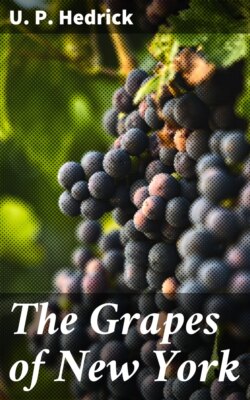Читать книгу The Grapes of New York - U. P. Hedrick - Страница 32
На сайте Литреса книга снята с продажи.
10. VITIS CORDIFOLIA Michx.
ОглавлениеTable of Contents
1. (?) Linnaeus, Sp. Pl., 1753:203. V. vulpina. 2. (?) Marshall, 1785:165. V. Labrusca. 3. (?) Walter, 1788:242. V. vulpina. 4. (?) Willdenow, 1:1181. 1797. V. Vulpina. 5. Michaux, 2:231. 1803. 6. (?) Bartram, Dom. Enc., 5:291. 1804. V. serotina. 7. (?) Muhlenberg, 1813:27. V. vulpina; V. cordifolia; Winter grape. 8. Pursh, 1:169. 1814. V. incisa; V. vulpina; Winter grape; Chicken grape. 9. Nuttall, 1:143. 1818. 10. Elliott, 2:688. 1824. 11. Rafinesque, 1830:15. V. vulpina; Frost grape; Winter grape; Fox grape. 12. Prince, 1830:194. Winter grape; Chicken grape; Frost grape; V. serotina; V. incisa; V. vulpina. 13. Torrey, Fl. of N. Y., 1:147. 1843. Winter grape; Frost grape. 14. Le Conte, Proc. Phil. Acad. Nat. Sci., 6:273. 1853. V. pullaria; Chicken grape. 15. Darlington, Fl. Cest., 1853:50. Chicken grape; Winter grape; Heart-leaved Vitis. 16. Buckley, U. S. Pat. Off. Rpt., 1861:483. Winter grape; Fox grape. 17. (?) Saunders, U. S. D. A. Rpt., 1869:82, 85, 87. 18. Engelmann, Mo. Ent. Rpt., 1872:60. Winter grape; Frost grape; Chicken grape. 19. Ib., Bush. Cat., 1883:10, 11, 12, 14, 17. Frost grape. 20. Bush., Ib., 1883:24. 21. Munson, Am. Pom. Soc. Rpt., 1885:97, 98. 22. Ib., Am. Hort. Soc. Rpt., 1885:133. Frost grape; Sour or Pungent Winter grape. 23. Planchon, De Candolle’s Mon. Phan., 5:323, 350. 1887. V. vulpina, var. cordifolia; V. vulpina; V. Virginiana. 24. Munson, Gar. and For., 3:474. 1890. 25. Ib., U. S. D. A. Pom. Bul., 3:12. 1890. 26. Britton and Brown, 2:410. 1897. Frost grape; Chicken grape; Possum grape; Winter grape. 27. Bailey, Gray’s Syn. Fl., 1:424. 1897. True Frost grape; Chicken grape; Raccoon grape; V. pullaria; V. vulpina, var. cordifolia. 28. Beach, N. Y. Sta. An. Rpt., 17:557. 1898. 29. Munson, Tex. Sta. Bul., 56:218, 231, 240. 1900. Sour Winter grape; Frost grape. 30. Viala and Ravaz, Am. Vines, 1903:42, 76.
Vine very vigorous, climbing. Shoots rather slender; internodes long, slightly angular, usually glabrous, sometimes slightly pubescent; diaphragms thick; tendrils intermittent, long, usually bifid. Leaves with short, broad stipules; leaf-blade medium to large, cordate, entire or sometimes indistinctly three-lobed; petiolar sinus deep, usually narrow, acute; margin with rather coarse angular teeth; point of leaf acuminate; upper surface rather light green, glossy, glabrous; glabrous or sparingly pubescent below. Clusters medium to large, loose, with long peduncle. Berries numerous and small, black, shining, little or no bloom. Seeds medium in size, rather broad, beak rather short; chalaza oval or roundish, elevated, very distinct; raphe a distinct, cord-like ridge. Fruit usually sour and astringent and frequently consisting of little besides skins and seeds. Leafing, flowering and ripening fruit very late.
Owing to the fact that Cordifolia and Riparia have been badly confused in the past, the limits of the habitat of this species are difficult to determine. Pursh gives the northern limit as Canada, and Buckley speaks of its being found at Lake Winnipeg, but all other, and some probably better informed, authorities give the northern limit as New York or the Great Lakes. The eastern limit is the Atlantic Ocean and the southern limit the Gulf of Mexico. It extends westward, according to Engelmann, to the western limits of the wooded portion of the Mississippi Valley in the North, and, according to Munson, to the Brazos River, Texas, in the South. It is found along creeks and river banks sometimes mixed with Riparia, having about the same soil adaptations as that species. It is a very common species in the Middle States and is frequently found growing on limestone soils but, according to Viala, is not indigenous to such soils.
It might be said that this species was first described by Linnaeus in 1753 under the name Vulpina, as his description was from mixed specimens of Cordifolia and Riparia. The first description, however, of which there is no question is that of Michaux in 1803. From this time on there are many descriptions under various names and much disagreement as to the limits of the species and its relation to Riparia. Engelmann in 1872 states that Riparia is generally a smaller plant than Cordifolia and that the fruit ripens earlier and is pleasanter tasting. It was still considered by many botanists that these differences were too slight to separate the forms as different species, but in 1883, Engelmann further enumerated other differences which are given under the description of Vitis riparia. Since this time, the specific difference of the two forms has never been questioned.
Cordifolia makes a good stock for grafting, being vigorous and forming a good union with most of our cultivated grapes. It is seldom used for this purpose, however, on account of the difficulty of propagating it by means of cuttings. For the same reason vines of it are seldom found in cultivation. It is probably of no importance horticulturally.
